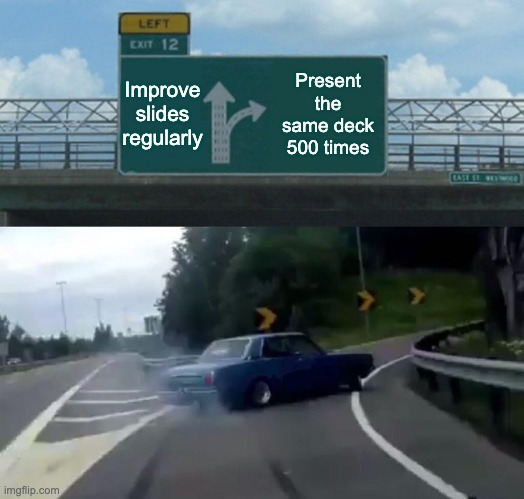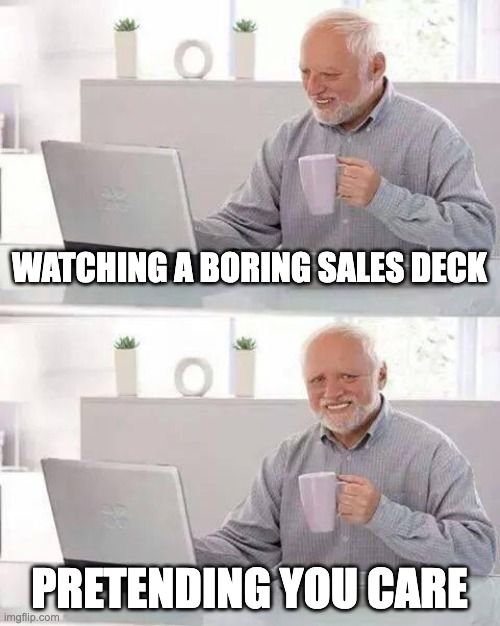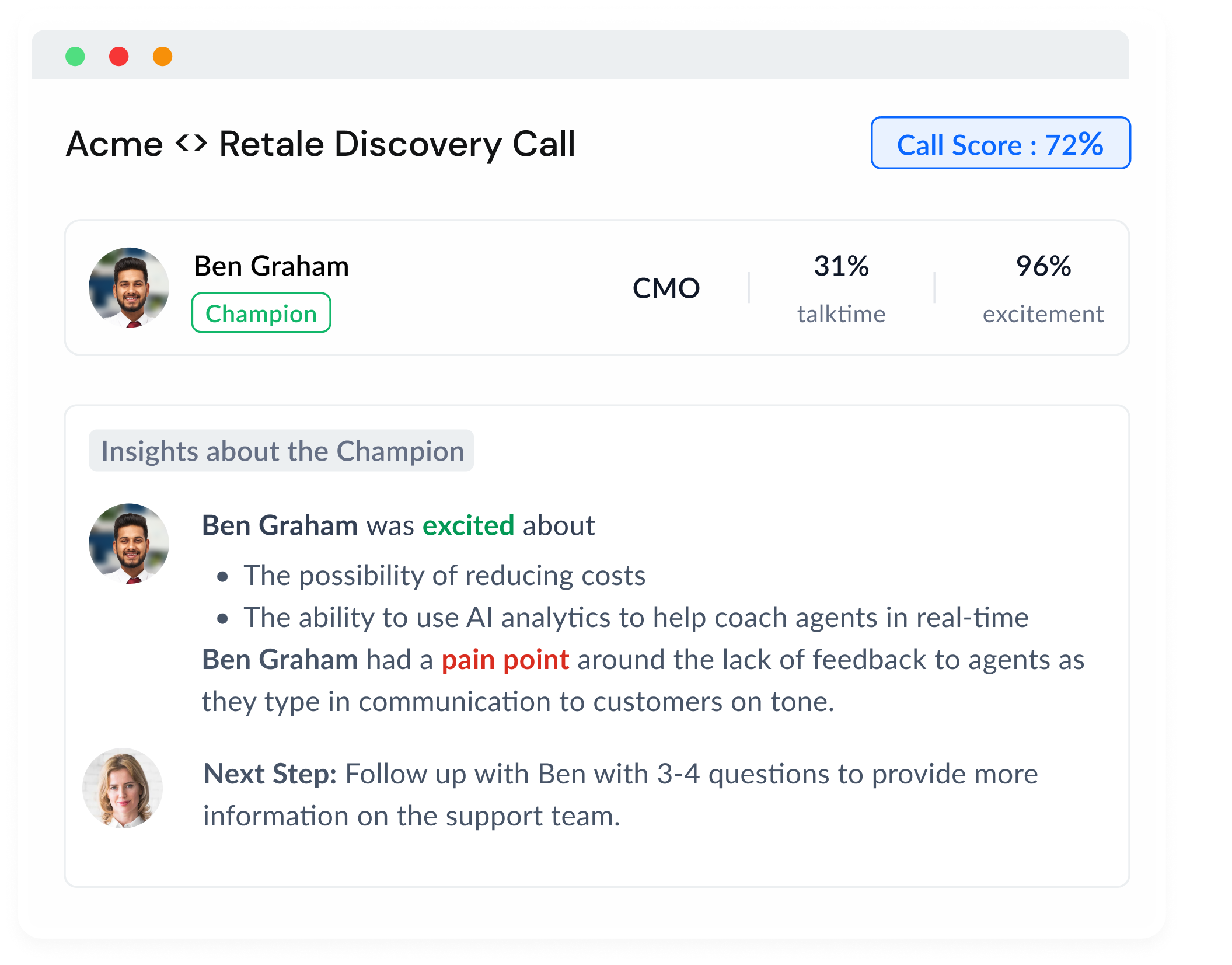Does your sales process involve multiple stakeholders?
You need a sales deck.
Do you solve a use case that needs a bit of explaining?
You need a sales deck.
The demo-only approach doesn’t work anymore. And boring or irrelevant sales decks are the kiss of death for your hard-earned opportunity.
You might wonder: if you are a sales leader or rep, is creating or maintaining a sales deck your responsibility at all? Isn’t it all down to the marketing/content teams?
It's often (or should be) a shared responsibility. What actually transpires when you are on a sales call matters a lot in shaping the narrative of your customer in your sales deck.
The salesperson is the one responsible for the deal outcome, and as such, responsible to figure out which slides need to be shown at what points in the sales process and with what talktrack.
The insights come from sales, while the creativity might come from either sales or marketing.
How to create an engaging sales deck - it’s about the story
It’s (too) often said that the best decks tell a coherent story that succeeds in persuading the audience. While that’s true, I would modify it a bit.
The story is not just in the deck - it’s also in what you say during a presentation or a call even when you are not presenting the deck.
A sales deck acts as an accessory to clarify the message, illustrate the broader points, or provide support in the form of case studies or testimonials to the discussion. Individual slides add color to the overall story that you are telling.
And you are telling a story. One in which your prospect is the hero. Always.
To learn more, read StoryBrand by David Miller - the most successful stories involve the prospect as the hero, going from their initial state to a far better state with obstacles in between. You, the salesperson, and your product or service are but a guide to help them make the transition.
That being said, the goals of the CXOs, the economic buyers, the implementers, and the end-users might all be different and might require different storylines and decks.
Some general tips that help in creating a compelling sales deck are:
- Include what you think is required to build a strong storyline. The use cases that your product solves, how it fits into your buyers’ workflow, how it plays along with other departments like legal and finance, and how it eventually makes the end user a hero, and the buying decision a success.
- Include social proof wherever possible. Names, pictures, and screenshots work really well.
- Customize the deck for each opportunity, as much as necessary. A customer's specific pains or situations deserve specific treatment in your deck. Nobody likes sitting in on a generic presentation.
- Use graphics and statistics to make a lasting impression and convey more information with fewer words, especially with executives. These assets boost recall and can become talking points in internal discussions.
- Do vary the deck for the purpose that it is solving in your overall sales process (leading the conversation OR clarifying certain points OR providing data and testimonials OR all of the above)
- A little bit of humor and color wouldn’t hurt, especially since listening to a presentation is typically not the most fun part of the sales process for the buyer.
Delivering a presentation is a big topic in and of itself. Here's one quick tip though - don’t do a 40 min monologue, please. Break it up, ask questions and engage your audience during the call.
Why it’s hard to get the sales deck right in one shot
It’s hard to get your sales deck right in one shot.
Not just for you but also for your marketing team. Here’s why:
- Your story is based on your knowledge of the target market - but it is a hypothesis the first time around, especially when selling a new product. You don’t know whether a story told by your deck is merely mediocre or truly jaw-dropping until you test it out. You don’t know which slides are confusing until you see confused faces on a call on presenting them. And wonder what on earth you are doing there.
- Even if you create a reasonably good deck in the first go, the product changes, the branding changes, the messaging changes, and you need to keep abreast with everything. You need to keep iterating based on these changes. For example - it may make sense to focus on different parts of your story in a bear market versus a bull market.
- Often, the deck is a collection of self-sufficient slides, which the salesperson can use as and when needed. You need to keep iterating on what slides to show at what stage of the deal and to which persona for the best impact.
The cost of not creating a process of improving sales decks
Decks get stale over time, and without constant improvement and iteration, the stories don’t work (read the section above).
And if the story doesn’t work anymore, it leads to:
- Bored prospects, leading to a loss of interest in the deal
- Perceived lack of competence and likeability in the salesperson (who likes a presenter who bores them? Remember your college professors…)
- A sense of wasted time, reflecting poorly on the company and product.
- Limited learning about how to frame the problem, present the solution, and establish a position in the mind of the prospect. This is especially bad for a new product or a startup.
Poor decks lead to bad results.
But how does one iterate on the sales decks over time? And how do you know if the iteration is in the right direction?

How to improve your sales decks consistently
Iteration on your sales collateral, especially your sales deck, is an ongoing process. You do need buy-in from your leadership, and in my experience, most salespeople who care about their customers’ experience and self-improvement do get it.
- Maintain strong collaboration with marketing and product teams. Be up-to-speed with product updates, messaging updates and hypotheses, and even help out with testing them.
- Test out ideas verbally for new slides or new stories in sales calls, and see if they work well. Then take that feedback to sales enablement/marketing to improve the deck or make some slides yourself.
- Measure engagement on slides over time to identify weak spots and areas of improvement. For slides sent over email, DocSend and other such tools help. To measure engagement on your sales calls, you can use Sybill’s Deck feature. It captures prospect engagement over each slide over all of your calls and shows your slides in a ranked list based on it. This helps you figure out which slides are working and which ones are zoning out your prospects. A/B test slides, or cut down your deck lengths accordingly to improve engagement and call outcomes.
Conclusion: Create, deliver and iterate on your decks to improve sales outcomes
Like many things in rapidly evolving roles like sales and marketing, creating effective sales decks is both an art and a science.
There are more guides to creating effective sales decks, and this one by SalesHacker is pretty comprehensive.
Measuring and improving the performance of your sales decks is a very nascent field. As of 2022, Sybill is the only tool that can help you gauge the engaging power of your slides from call data due to its focus on understanding body language and facial expressions.
Do check it out.
Deliver engaging decks with strong storylines and keep iterating to stay ahead of the curve!















.png)



